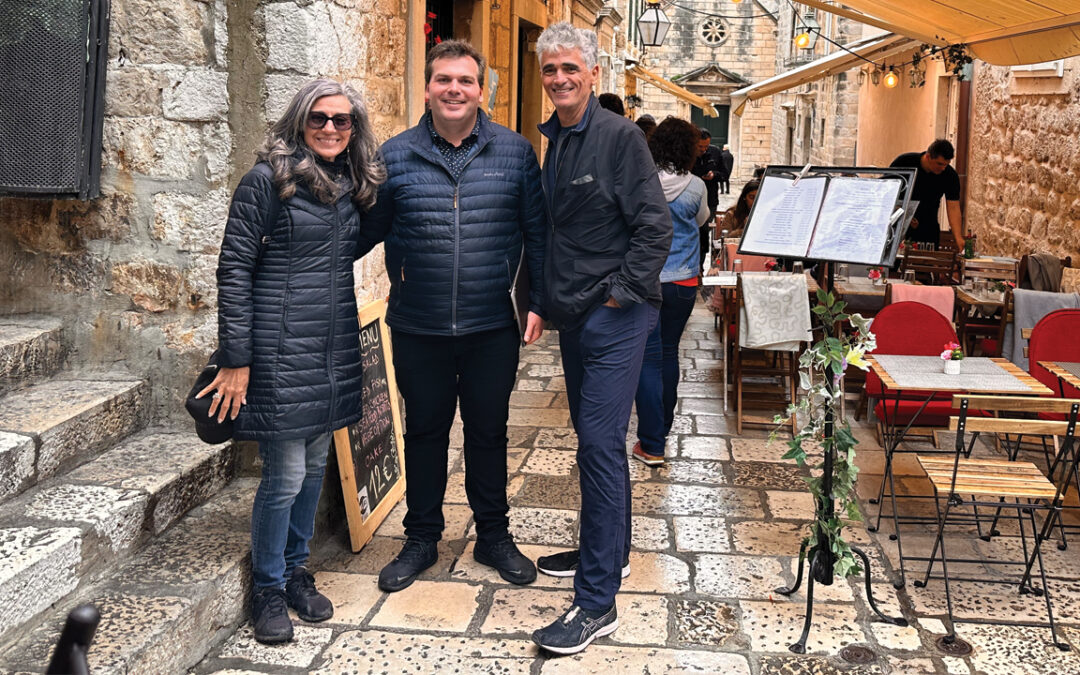Shameless Selling.
I had to go all the way to Croatia to learn about Shameless Selling.
On a small pedestrian passageway high up in Dubrovnik’s Old Town, Frano Banić (pronounced “Ban-ich”) runs his family’s small restaurant.
Frano’s responsibilities include provisioning, hiring, scheduling, and overseeing everything else necessary to serve breakfast, lunch, and dinner to crowds of hungry tourists.
But Frano’s most important job is shameless selling because people don’t just wander into Frano’s restaurant; instead, they need to be lured in. So most days you’ll find Frano standing by the front entrance, trying to engage each passerby and invite them to have a seat and order off his menu.
While enjoying our lunch, I started listening to Frano’s pitch. I realized that because there were so many indistinguishable restaurants on the narrow street, Frano needed to guide people into his little bistro. It dawned on me that what I was seeing was not just a random pitch but a masterclass in shameless selling. Not only that, but unlike so many of the marketing programs I’ve been involved with that take a long time to implement and evaluate, Frano knew instantly if his pitch worked.
Or not.
After listening for a while, I went up and introduced myself. I told Frano I had written books and blog posts on sales and marketing and was fascinated by what he was doing. I wanted to ask questions about shameless selling, and I promised to stay out of his way while he welcomed in more tourists.
I learned Frano understood the people walking past his establishment were probably interested in eating, but not at his restaurant. That meant he had seconds to size them up, figure out what they were looking for, and try to entice them quickly and effectively.
Frano began each interchange in English because it’s the most widely used language. But he’d immediately switch to German, Spanish, French, or any regional dialect if he perceived his prospect was more comfortable with that language. He also asked questions to find out what his potential customer wanted – something heavy or light, soup, salad or seafood, coffee or a drink, perhaps, or just a place to sit and relax. All the while, he was offering his menu and trying to steer his customer towards a seat.
When I returned to our table and relayed what I learned, my daughter said she had a similar experience working for PETA (People for Ethical Treatment of Animals). Ali’s job was traveling across the country, setting up displays, and discussing our modern food system and the value of a vegan diet. Like Frano, Ali told me she had to quickly size up her audience and determine the message that would work best to introduce them to animal rights.
Some people were interested in saving animals.
Some people were interested in saving the planet.
Some people were interested in saving their health.
Some people were interested in saving humans.
Like Frano, Ali told me she had to deal with constant rejection and quickly move on to people she’d have more chance to connect with. Frano told me that roughly 10% of the people he talked to walked into the restaurant. Ali didn’t know how many of the people she spoke to stopped consuming animal products. instead, she counted her successes based on the number of people who stopped, engaged in thoughtful conversation, and thanked her for the information.
When I asked them how they dealt with constant rejection, I got essentially the same answer. And I learned a new definition of a term I thought I understood but didn’t: “Shameless Selling.”
Frano said that if he didn’t stand in front of his restaurant and invite people in, his employees wouldn’t get paid and his family wouldn’t survive. He was passionate about what he did because he was passionate about his family.
Ali said that because of her commitment to animal welfare, accomplishing her goal to make the world a better place for all species was more important than her momentary feelings. She explained that she shamelessly approached each passerby because each interaction gave her a chance to save more animals.
Thanks to their explanations, “Shameless Selling” took on a new meaning for me. Here the term was not a pejorative explanation of a sales pitch, but an explanation that when you believe in what you’re doing with all your heart, there’s no shame in selling it.


Thanks for this Bruce! I 100% agree that passion (The “Why”) must be the foundation for anything we sell. And, for those of us who sell to more targeted audiences, we have much to learn from Ali and Frano. Fundamentally, they are gathering data on why their customers choose their cause, product or service. When we focus on truly understanding that, we save valuable time for ourselves and our prospects.
Great tale, Bruce. Brings to mind two points: If you don’t sell, you don’t eat – and the more creatively you pitch your brand and engage strangers, the more success you’ll serve up.
And, tangentially, when we roadtrip, we never eat at chain restaurants. I didn’t drive to Nashville (via Muscle Shoals, btw) to have frickin’ Applebee’s.